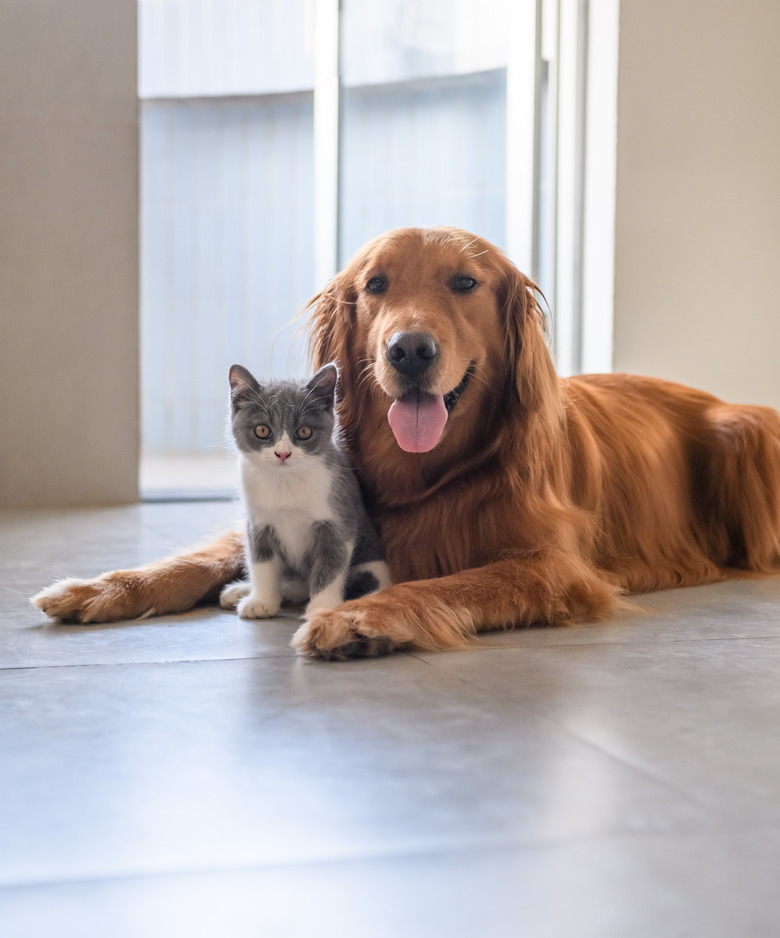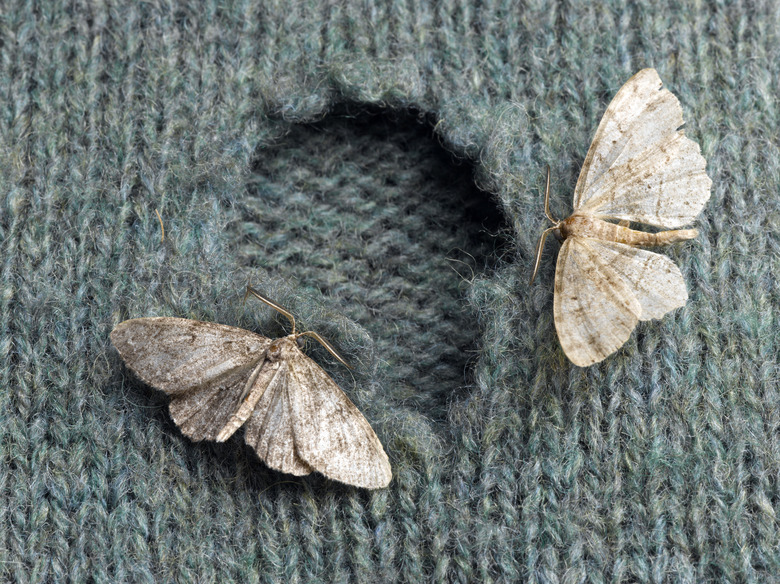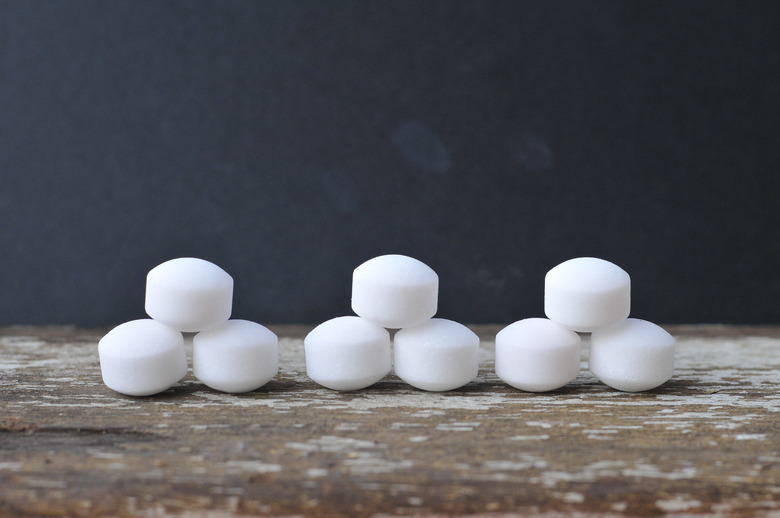Are Mothballs Harmful To Cats And Dogs?
Once you've smelled mothballs, you never forget that distinctly pungent, repulsive odor. And if you smell them, you're inhaling insecticide, says the National Pesticide Information Center. Mothballs are fumigants and contain highly volatile chemicals.
Acting as a repellent and an exterminator is the job of mothballs; the intended purpose is to kill and repel clothes moths and their larvae (webbing clothes moth and casemaking clothes moth), and other fabric-infesting pests like carpet beetles in stored clothing and fabric. But they can also be a household hazard to pets and everyone else in the home.
Often used to discourage wildlife such as raccoons, squirrels, skunks, pigeons, and snakes and other home invaders like mice and rats from setting up house in attics and crawl spaces, this misapplication should be avoided, says VCA Hospitals and the National Pesticide Information Center. Since mothballs are solid pesticides that release toxic vapors at room temperature, they should never be used indiscriminately as is so often the case when people scatter the loose balls willy nilly. Mothballs are designed to be used within a sealed container that safely contains the fumes for the purpose of repelling/killing only insects.
Composed of nearly 100% active ingredient — either naphthalene or paradichlorobenzene, known as PDB (a carcinogen) — mothballs are toxic to dogs, cats, people, and the environment. As little as one mothball can be toxic when ingested by a dog or cat. When used and stored properly, mothballs are relatively safe to have in a home with pets, states VCA Hospitals. But as a pet parent, why take a chance when there is always the potential for inhalation or accidental poisoning even if following the directions exactly, and when there are safe alternatives to controlling clothes moths that pose no threat to your pets and other family members.
Moth repellent products and how they work
Moth repellent products and how they work
Moth repellent products run the gamut with many forms available; from balls, cubes, spheres, and powder to scales, flakes, and cakes. For years, mothballs were made with naphthalene, a highly toxic and flammable insecticide that is rarely used these days. This "old-fashioned" product is still the most toxic of the moth repellents. Most modern moth repellents are made with PDB, and sometimes camphor, an organic compound known as terpenoid that has a strong aroma. Nevertheless, all are toxic.
Mothball vapor kills clothes moths that are trapped inside sealed, airtight containers, and the balls slowly disappear, turning into gas and mixing with the surrounding air. The vapor sticks to clothes and fabrics which need to be aired out or washed after exposure to mothballs during storage.
Not designed for use outside, mothballs contribute to air pollution, harm wildlife, and contaminate water supplies, plants, and soil.
Symptoms and effects of mothball poisoning
Symptoms and effects of mothball poisoning
Each of the insecticide ingredients in the various moth repellents has its own unique health effects if chewed or eaten by cats or dogs, the severity of which is dependent on the size of the mothball and the concentration of active ingredients — different manufacturers use different insecticides and varying ratios of the active ingredient. Also, some mothballs are illegal and imported from other countries bearing no ingredient list, thus toxicity is unknown.
While dogs have more of a propensity to chew and consume mothballs, cats are more sensitive to inhalation of the highly concentrated insecticide. That said, long-time exposure to the fumes of mothballs are harmful to both cats and dogs, and people, as well.
Naphthalene mothballs can cause anemia, weakness or lethargy, vomiting, and sometimes damage to the kidneys or liver, explains VCA Hospitals. While PDB mothballs are less toxic, they still cause illness in pets, and adverse effects include vomiting, nausea, shaking or tremors, and potentially kidney or liver damage.
In addition, here are some other common clinical signs of mothball poisoning in dogs and cats, according to VCA Hospitals:
- Mothball-scented breath.
- Pale or brown gums.
- Labored breathing.
- Seizures
Keep in mind that mothballs dissolve slowly if ingested, so you may not recognize any signs of poisoning in your pet for a few days.
What should you do if your cat or dog eats a mothball?
What should you do if your cat or dog eats a mothball?
Always being prepared for a pet emergency is second nature to pet parents. That means keeping your veterinarian on speed dial along with the number of the nearest veterinary emergency hospital, the 24/7 ASPCA Poison Control Center 888-426-4435, and the Pet Poison Helpline's number 855-764-7661. If you suspect your dog or cat has eaten a mothball or even nibbled on one, seek professional help and take your pet to a vet as soon as possible. Do not induce vomiting.
Treatment and prognosis of mothball poisoning
Treatment and prognosis of mothball poisoning
There is no antidote for mothball poisoning, but if your dog or cat is decontaminated and receives supportive treatment quickly enough, the prognosis for a full recovery is favorable. Consequently, most pets can survive the event. However, in animals who have a compromised immune system, or are already sick or elderly, the odds of recovery may exponentially decrease.
Most importantly, fast and aggressive treatment is essential. If your cat or dog has just eaten a mothball, yet is not showing any symptoms of poisoning, your vet may induce vomiting, explains VCA Hospitals. This action serves to remove the mothball and prevent the absorption of the chemicals. Activated charcoal may be administered at this time, as well.
In the case of clinical signs of poisoning, your vet will perform various tests based on the symptoms, and may include the following:
- Blood work to determine the presence of anemia or damage to the liver and kidneys.
- Administer IV fluids to protect the kidneys.
- Administer anti-vomiting medication, anti-seizure medication, and medication to protect the liver.
- X-rays, which may show if any mothballs are present in the stomach or intestines.
- A blood transfusion may be necessary in severe cases.
- Continue to monitor recovery with follow-up blood work, ensuring your dog or cat's red blood cell count and liver and kidney function reaches or maintains normalcy.
The expected outcome of mothball poisoning for a dog or cat with no pre-existing kidney or liver damage is good, says VCA Hospitals.
Prevention of mothball poisoning
Prevention of mothball poisoning
Of course, discontinuing use of mothballs is an excellent option. But if you do choose to use mothballs, the appropriate storage and usage is key. Store mothballs in a locked cabinet out of reach of pets and children in an airtight, sealed container. Only use mothballs in an airtight, sealed container such as a garment bag or plastic bin with tight-fitting top (airtight) that does not allow dangerous fumes to escape into your living space, and do not use outdoors where mothballs can harm pets (your own and others) and wildlife, and contaminate the environment.
Safe use of mothballs also requires you to carefully follow the label instructions to a T.
Mothball alternatives
Mothball alternatives
Consider mothball alternatives to controlling fabric-infesting pests in long-term stored clothing and fabrics or if you have an existing infestation. Here are some tips for storing your clothing and dealing with a fabric pest infestation:
- Dry clean any clothes before storing them, which gets rid of the adults, eggs, and larvae of moths, carpet beetles, and other insect larvae that feed on fabric.
- For an existing infestation, empty and wipe down dresser drawers with a household cleaner and dry clean clothing.
- Consider consulting a highly qualified, trained pest control professional for advice on using boric acid dust safely and strategically in your home, how to prevent clothes moths and fabric pests, or inquire about a guaranteed treatment for fabric-infesting moths performed by professional technicians.
Conclusion
Conclusion
Mothballs are harmful to dogs and cats, and as solid pesticides, they contain almost 100% active ingredients that are poisonous, even if only one mothball is ingested — eating a mothball is more likely for dogs, and cats are particularly sensitive to the toxic vapor.
When mothballs are stored or used improperly such as thrown loose into an atiic or closet or for any use other than killing fabric-infesting insects in a sealed, airtight container, they become a hazard to pets and people in the home, and never use mothballs outdoors.
If you have any loose mothballs anywhere in or around your home, gather them with gloved hands and store or use them as directed, or dispose of them appropriately.
If your cat or dog eats a mothball or you suspect the fumes have affected your pet, seek veterinary care immediately.
Always check with your veterinarian before changing your pet's diet, medication, or physical activity routines. This information is not a substitute for a vet's opinion.
References
- VCA Hospitals: Mothball Toxicity in Dogs and Cats
- National Pesticide Information Center: Health Effects of Mothballs
- U.S. Library of Medicine" Napthalene
- National Pesticide Information Center: Regulation, Proper Uses and Alternatives
- Oregon State University: Mothballs: Proper Use and othballs: Alternative Controls for Clothes Moths
- VCA Hospitals: Mothball Toxicity in Cats


